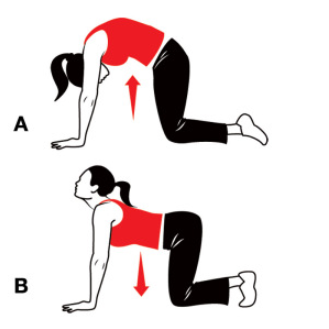I bet if you asked most of people that you know what sort of aches and pains are the most prevalent during their day-to-day lives, low-back pain would be at the top of that list. Low-back pain has almost become an epidemic! When you look at the most common risk factors associated with low-back pain, it makes a lot of sense as to why.

Common Risk Factors Associated with Low-Back Pain:
- Prolonged static postures (i.e. sitting all day long)
- Stress or depression
- Poor physical fitness
- Obesity
- Pregnancy
- Inherited or other diseases (i.e. disc disease, osteoarthritis, rheumatoid arthritis, etc.)
So, considering these risks, what actually causes low-back pain?
Most Common Causes of Low-Back Pain:
- Mechanical Pain
- Degenerative Disc Disease
- Sciatica
Mechanical Pain
This type of low-back pain usually occurs when specific movements are involved. This is due to anatomical deviations or abnormalities in the discs or joints. Pain occurs when stress is repeatedly placed on these injured structures. These deviations or abnormalities weaken the support due to poor muscular strength and flexibility. Mechanical pain may also cause muscle tension, muscle spasms, and certain myofascial restrictions.
Degenerative Disc Disease and Sciatica
DDD typically occurs due to the aging process and appears in individuals between ages 30-50. What happens is the intervertebral disc gradually wears down and eventually degenerates. Disc herniations and bulging discs occurring between the 4th and 5th lumbar vertebrae (or between the 5th lumbar vertebra and 1st sacroiliac joint) are fairly common occurrences that go along with DDD. Sciatica or other types of nerve radiculopathy occurs if the nerves coming out of the spinal cord due to DDD or disc herniations causing “pinching”. Often, individuals will be able to identify a clear path of pain, tingling, and even numbness in the affected nerve area.
4 Daily Stretches to Relieve Low-Back Pain
So, now that we know some of the risk factors associated with the development of low-back and the most common causes, let’s take a look at some ways minimize, if not significantly reduce, the pain. Along with spending more time standing than sitting and introducing regular physical activity and more movement into our life, look to include these 4 stretches in your daily routine.
I recommend doing these stretches both first thing in the morning and right before going to bed.
Perform each movement for 30-60 seconds, with 30 seconds of rest in between. Perform 1-3 rounds.
Cat-Camel

Note: Focus on the “pushing” movement at the end ranges of motion of flexion & extension.
Modified Curl-Up

Note: Be sure to have a towel or hands under your lumbar spine to keep your back in the neutral spine position. Avoid flattening your back on the floor.
Bird Dog

Note: Avoid rotating your torso or dropping your hips. Keep your back completely flat as if you were a table top and there was a glass of water on it.
Side Bridge


Note: Create a straight line with your neck and spine. The goal is to maintain a neutral neck and spine position while holding the bridge. (First one is the modified version.)
These daily stretches will help you learn how to properly stabilize your trunk in a more neutral position. This daily practice should assist in remarkably quieting that low-back pain.
Some things to avoid due to the high stress that can be placed on the spinal structures:
- Overhead pressing without some type of back support
- Repeated bending and/or twisting
Hopefully you found this informative and helpful! Feel free to reach out to me for any questions, comments, or feedback.
Until next time,
Aurora Arlt



